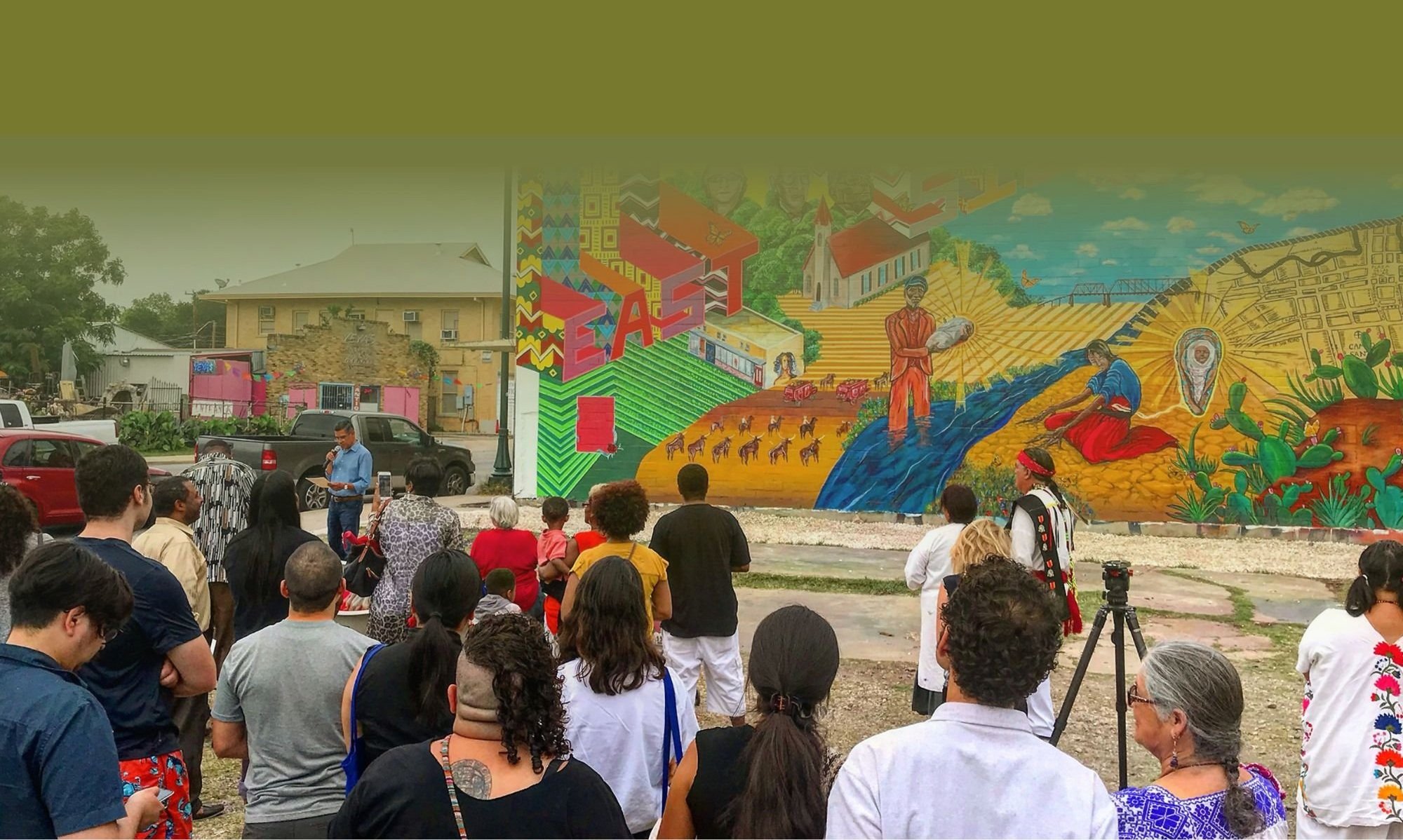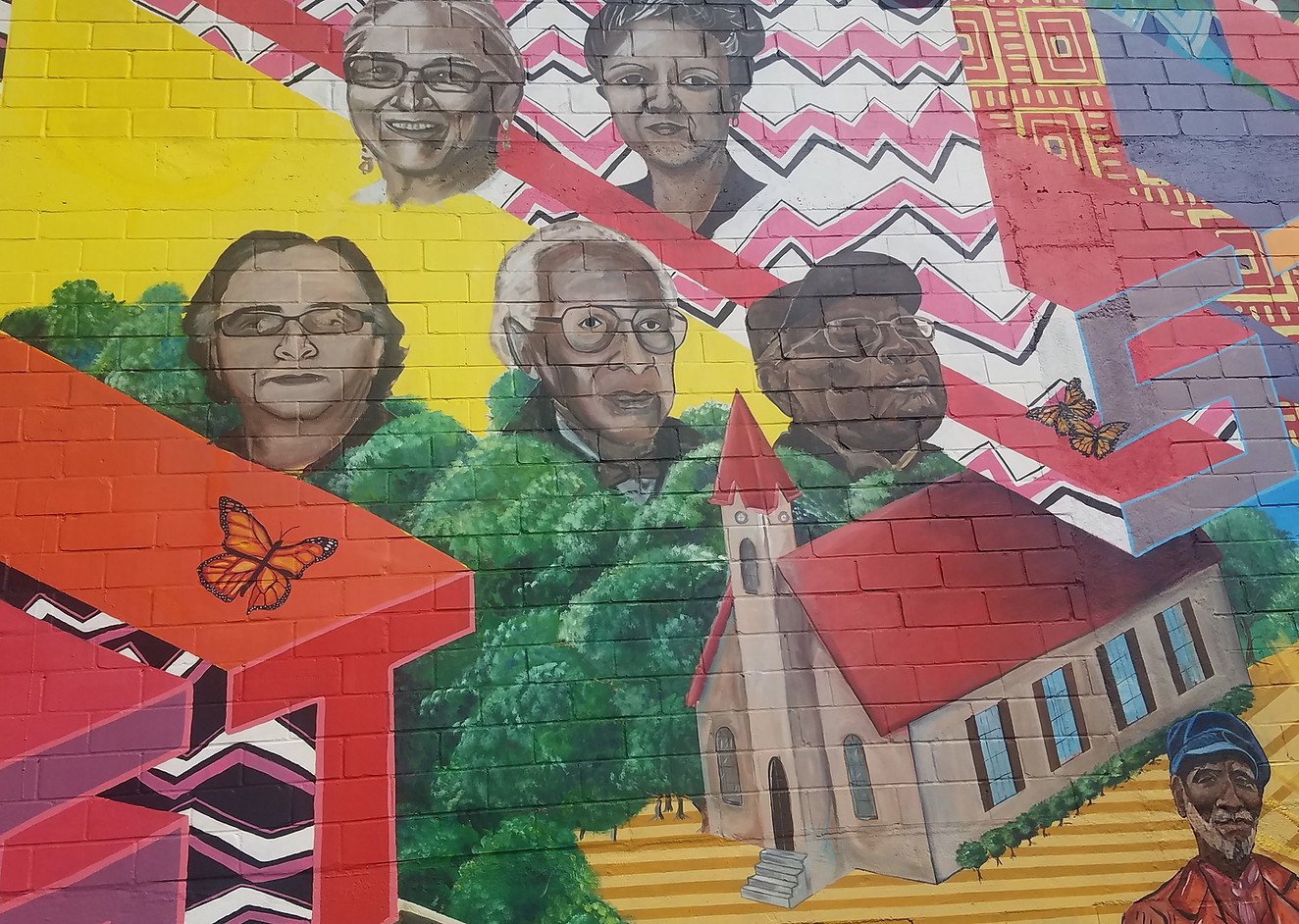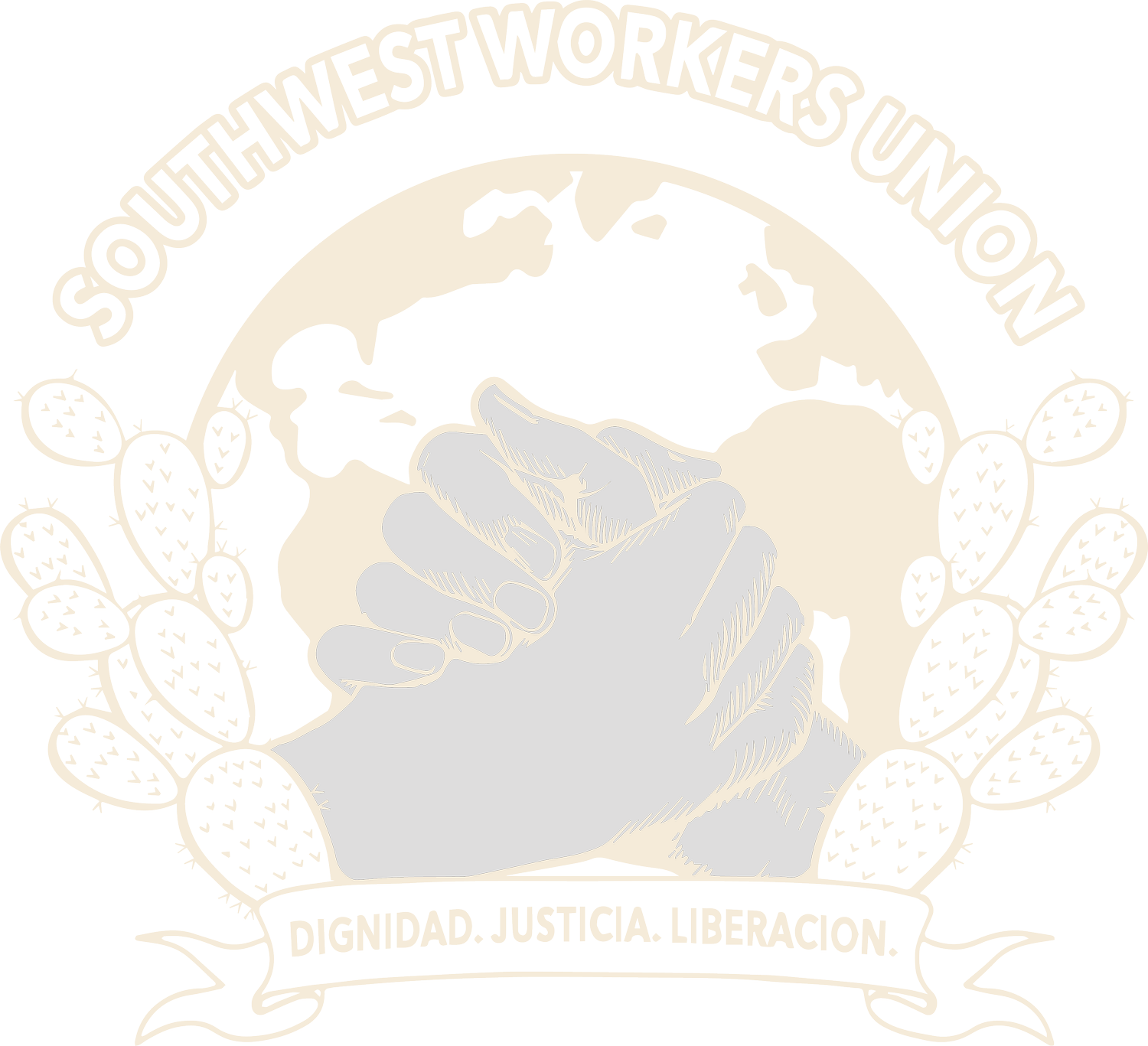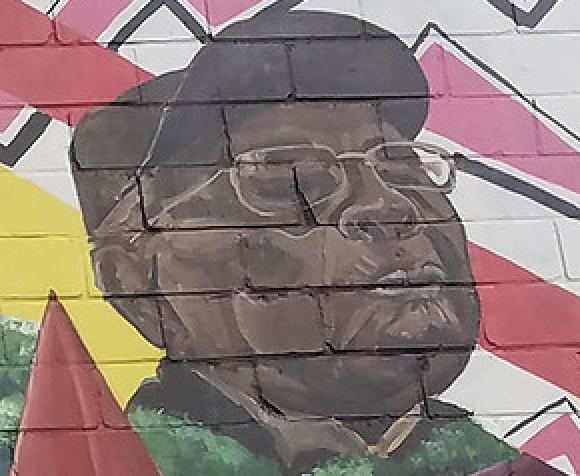
The 30 Year Anniversary Mural
In celebration of Southwest Worker's Union's 30 years of organizing we teamed up San Anto Cultural Art's (SACA) muralist and organizers at the American Indians in Texas at the Spanish Colonial Missions (AIT) to paint a picture of 300 years of resistence, and the deeper history of San Antonio. The team hosted several community meetings to gather stories and ideas to contribute to the design. The crew then got to work and finished the mural in one month in time for our annual May 1st, International Workers Day celebreation and mural unvailing.
"Love is Eastside" Mural
Mural Coordinator: Victor Zarazua
Lead Artist: Rudy "Cholotears" Herrera
Assistant Artist: Ana Hernandez, Rhys Memro, Jason Eric Gonzales Martinez
Volunteers: Emma Diaz, Albert Garza, Adri Garza, Amelio Greene, Kira knelel, Matilda Gonzales, Alice, San-tia Moen, Enrique Cortinas Jr., Karla Aguilar, Crystal "cry" Tamez, Santiago & Christian, Becca & Redbull.
The concept behind this piece is built around the indigenous peoples of San Antonio and the relationship they have had with the flora and fauna, the growing populace, technological advances, and the ever-changing landscape. It also acts as a welcoming visual to those entering the East Side on Commerce St.
A CLOSER LOOK.
Native Inhabitants
Long before the so called tricentennial of San Antonio, many tribes inhabited the region including the Carrizo, Pajalate and Payaya among others who were later called Coahuiltecos. The Tap Pilam which means “people of the earth” in their Pajalate language, are symbolically pictured in blue like drops of water to honor their relationship to the spring waters of their origin story. As hunter gatherers they moved frequently while living in harmony with the land. Also included is a portion of a map of the early Westside by Tribal Council leader Ramon Vasquez Y Sanchez.
Early Eastside
The early Eastside consisted mainly of farm lands and through the systematic racism practices of red lining and segregation, the Eastside became home to the growing African American population of San Antonio. Also pictured is our own Southwest Worker's Union building with a miniature version of our iconic original mural piece by artist Adriana Garcia. The man in the river is self taught artist and self proclaimed Rev. Mr. Perkins, shown with a child symbolic of the local Eastisde Baptist community and their hopes for the future.
Connections to the Land
Indigenous people have been in the San Antonio area for over 15,000 years, establishing communities along the vital waterways and creating camps planned with the seasonal harvests of food such as agave and prickly pears and medicinal plants. The rivers and sacred springs were used to sustain the community and were highly respected as the origin of life for many clans and tribes. The Historic Hays St Bridge is used to signify building bridges within our community, it played a role in connecting the Eastside to San Antonio and is an important symbol of the anti-gentrification fight in San Antonio. The butterflies throughout the mural symbolize migration and the movement of people as a human right.
Cultural Leaders
Included in the mural are a few individuals that played an important role in reservation of local indigenous history or leading stewards of the Eastside community. Also shown are facilities like the Mt. Zion Church that became a cornerstone for organizing in the African American community of San Antonio. Elders featured:
Linda Ximenes (top left), Hattie Elam Briscoe (top right), Steve Casanova (bottom Left), John Inman (bottom middle), and Paul White (bottom right), and Rev. Seymour Perkins (holding the child)

Histories & Stories
Contributions by Mario Marcel Salas, Elaine Ayala, Ramon Vasquez, Elaine Ayo, Rudy Herrera
Linda Ximenes
Linda is a ceremonial elder, environmental organizer, and consultant. She is part of the Tap Pilam of Coachuiltecan Nation and Xarame Clan. Linda Ximenes has played signature roles in Southwest Workers Union's fight against pollution at the Kelly Air Force Base, now known as Port SA as the effects continue to harm the surrounding community. Linda also has been active with working with the current Mayors housing task force in a attempt to help shape growing issues of development and gentrification in San Antonio.
Hattie Elam Briscoe
(Mario Salas)
According to documents at the UTSA Library, in the Special Collections Department of the John Peace Library, Hattie Elam Briscoe was the “First Black woman to graduate from St. Mary’s University School of Law, and was the only Black woman attorney in Bexar County for the next 27 years.” Hattie Briscoe was from Shreveport, Louisiana (1916). She was the recipient of a scholarship to attend Wiley College where she earned a Bachelor’s Degree in 1937. Wiley College students launched some of the first sit-in demonstrations in Texas against segregation and were the home of the Great Debaters. Wiley College would have helped to steel Hattie’s determination to break the chains of segregation.
Later that year she began a teaching career in Wichita Falls, Texas and served there until 1941. It was during this time that Hattie was wed to William M. Briscoe and moved to San Antonio. In the days of segregation it was normal for an ambitious woman to gain as much experience as possible to survive the constraints of a racialized society. Hence, Hattie became a licensed beauty salon operator, working with her husband in San Antonio at Briscoe’s Beauty Salon until 1945. At one point, and until her death, Hattie lived on the East Side, on S. Pine Street, in the Denver Heights, an area that was once a large black community.
By 1944, Hattie had become a cosmetology instructor, where she taught night classes at Hicks Beauty School. Hattie was forced to attend schools that were racially segregated in Texas, but despite the generally inferior nature of segregated education she excelled. Later she became an instructor of Cosmetology at the segregated Wheatley High School. Understanding the horrible nature of segregation, but yet never giving up, Hattie received a Master’s degree at then segregated Prairie View A & M College in 1951. In 1952, she entered St. Mary’s Law School, a Catholic institution, where she attended night classes while working in the day. It was no easy matter for Hattie to graduate from St. Mary’s being 40 years old in 1956 and working to support her education. Hattie Briscoe practiced law for 42 years, serving the black community until 1998, in the Dr. Preacher’s Professional Building, located at 1416 E. Commerce, which was an area that at one time the center of black life on the East Side..
According to the UTSA archives, “Briscoe was a member of the San Antonio Bar Association, National Association of Defense Lawyers in Criminal Cases, San Antonio Black Lawyers Association, Texas Bar Association, Texas Criminal Bar Association, American Bar Association, and the National Association of Black Women Attorneys.” She was also an active life member of the NAACP. Her loving relationship with William resulted in 47 years of marriage. She died on October 17, 2002.
Steve Casanova
(Elaine Ayala, San Antonio Express News)
Steve Casanova was head of the five tribal families of the Tap Pilam Coahuiltecan Nation in San Antonio. An associate professor of Chicano Studies at St. Cloud University in Minnisota, Casanova was the father of two boys, Said Ramon Vasquez, executive director of the American Indians in Texas at the Spanish Colonial Missions, which was established by Tap Pilam.
An activist in the Chicano Movement of the 1970s, Casanova was working on a book on mesquite trees and how they were used by ancient Coahuiltecans, Said friend and Artist Ramon Sanchez y Vasquez, The Coahuiltecans, are regarded as the first inhabitants of the area now known as San Antonio. "He was one of the persons that helped established Tap Pilam, Coahuiltecan Nation at San Antonio," Vasquez y Sanchez said. "He was the youngest, and I was the oldest." "Althouhg his family was related to the Canary Islanders, he was proud of his Native American heritage," the artist added.
John Inman
(Mario Salas)
John Inman was born in 1896 and was a fixture in the civil and human rights movement in San Antonio and across the city. Inman was a barber by profession, and had his community barber shop on S. Hackberry Street, diagonally across the street from Mt. Zion First Baptist to which he was a member. According to researcher Alwyn Barr, in quoting A.C. Sutton, John Inman was always in the lead for civil rights. Sutton said, “Anything that looked like a movement, he would be a part of.” After authorities discovered that Inman was a revolutionary they removed his barber shops from the military bases causing economic hardships. However, much to the displeasure of racists and segregationists Inman kept up the fight for human dignity. In 1928, John Inman became the president of the San Antonio Branch of the NAACP. He fought for infrastructure improvements on the East Side and carried out a campaign to end the poll tax. In 1957 John Inman also owned a barber shop at 703 S. Pine and was known as a revolutionary by his customers.
John Inman was a fighter for social justice for many years, John Inman, a black revolutionary during the Bellinger era, lived for a long time and fought for positive change for decades. He was socialist oriented and was able to establish strong working relations with the Mexican American community through Emma Tenayuca as they both fought for worker’s rights. John Inman was allied with Rev. Claude Black and the Sutton family, who were at various times connected to the socialist movement. John Sutton, brother to G.J. Sutton, an East Side State Representative, moved to the Soviet Union in the 1940s and helped the Soviet government in agriculture.
Members of the Communist Party were very active in San Antonio, dating from the time of Emma Tenayuca in the 1920s and 30s. John Inman was active with a black and brown coalition that organized into the “Workers Alliance.” Inman tried to get black support for the Pecan Sheller’s Union under the leadership of Tenayuca, His help was invaluable and shamefully his organizing has gone uncelebrated. In praising John Inman and his family, in La Voz de Esperanza (The Voice of Hope, 2007), John Stanford said that, Emma Tenayuca and John Inman, both were chairs of the Communist Party of Texas; Hattie Mae Inman (John Inman’s wife), who raised a family and was an inspiration to others while bedridden.
Paul White
(Mario Salas)
Paul White was one of the last eyewitness and participant to see the end of black businesses on E. Commerce Street. E. Commerce Street had a strong history of black life and culture that once dominated the area. Most of it is now gone as the result of a racist move to eliminate black businesses by making the street one way. After the street was made one wa,y and black businesses destroyed, it was returned to a two street to benefit the Zachry Corporation and downtown business interests that wanted to expand the business corridor east and gentrify the neighborhood. That process is still going on.
This was world of black barber Paul White. Paul White was a black barber and a fixture on the city’s near East Side. He mentored and hired such famous local barbers as Charles Williams. Paul lived at a time when black businesses existed up and down East Commerce Street. He cut hair at a time on Commerce Street when there was a black Cameo theater at 1123 E. Commerce, a black owned De Luxe Hotel at the corner of E. Commerce and Sycamore Street, the Lifesaver’s Bar and Grill and Bette’s Eat Shop in the 1400 Block of E. Commerce, Bellinger’s Taxi Cab Company, Red Top Cab and Fishers Café located on the northern side of the 1400 block of E. Commerce, Cunningham’s Pharmacy and Soda Shop at 1414 E. Commerce, the Avalon Grill and the Froggie Bottom Club at 1131 E. Commerce, Dr. Preacher’s Office, and more. At 1412 East Commerce, next door to the Cunningham Pharmacy, in the same building, was Taylor’s Barber Shop. Taylor’s Barber Shop is where famed barber Paul White worked and gave Charles Williams his first job.
When Paul White died he was 86 years old and would have many memories of the black side of town. He would have cut black soldiers hair from Fort Sam Houston and patrons from many of the black businesses and neighborhoods north and south of E. Commerce Street. Only John Inman, a black barber a few blocks away on South Hackberry Street was older than Paul White.
For 64 years, Paul White cut hair and demanded that his barbers be polite and conduct themselves in a very professional manner while working at his business. He was not very talkative but focused on the service he provided to his customers. White did talk a lot about sports and how black businesses in the area were destroyed along Commerce Street. Customers often noted how he looked out of his window and was saddened at what the city had done to destroy black businesses and the cultural life that went along with living in a segregated city. Charles Williams, owner of the Landmark Coffee Shop, said he gave him his start, and made sure to tell him that he should not be late to work.
In 1946, the shop was originally owned by Verley Taylor who hired Paul White after his service in the U.S. Army. Paul White was known to help those who could not afford a haircut and often did so for church members and strangers. The building he was a barber in is now being used by progressive fighters for social change. This is a fitting tribute to Paul White. Paul was married for 52 years to Geraldine White who preceded him in death.
Rev. Seymour Perkins
(Elaine Ayo, Express-News)
For decades, the self-proclaimed Rev. Seymour Perkins brought his own flavor to the corner of South Hackberry and Nevada streets, eliciting both praise and ire from his neighbors as he battled to save his house from city bulldozers. Perkins was an eccentric self-taught artist who earned a national reputation among collectors of so-called “outsider” art. It was a reputation almost unnoticed amid the controversies surrounding his house. City officials and some neighbors had called the house a haven for criminal activity and a dangerous, dilapidated building that needed to be torn down, but supporters of Perkins called it a priceless piece of San Antonio culture. Its walls had been adorned with paintings and drawings, but these works were lost when the house was damaged in an October (2008) fire. A November 1997 fire destroyed the initial stages of the museum Perkins was dedicating to his slain daughter, Debbie Jo.
In recent interviews, the retired crane operator from East Texas said he started his ministry for prostitutes and drug addicts after Debbie Jo was killed in a drug-related attack in 1994. Shortly before her death, Perkins said the angel Metatron appeared. “Angels,” the story of Debbie Jo, and other autobiographical bits and pieces mixed with broader statements on race in Perkins’ artwork. He painted portraits of figures real and re-imagined, with subjects ranging from Solomon Coles, the first black graduate of Yale Divinity School, to portraits of Theodore Roosevelt, Marilyn Monroe and Frida Kahlo depicted as African Americans. Check out Perkin's Artwork here
(Personal Story of Mr Perkins by Rudy Herrera)
When I was living off Hackberry and Kansas, my neighbor was Robert Tatum and his son was Mateo. Me and Mateo became good friends, almost like brothers, over the years, and Mateo was close friends with Mr. Perkins. Mateo would spend time hanging out with Mr. Perkins to get time away from things. One day, Mateo and I were on a extented business trip out of town that lead to Mateo missing a check in with his probation officer. This resulted in a warrent for arrest that threatened more prison time for Mateo. The night before reporting to parol with sure signs of prison time lingering, Mateo went to say good by to Mr. Perkins. Within that dialogue that night, Mr. Perkins planned and executed a note that was notorized by someone else in the Hackberry house that claimed Mateo was in custody of Mr. Perkins and his fellowship and they are the reason for Mateo's absene in court. After debating the issue with the parol officer Mateo was excused of the warrent and sent on his way. The child Mr Perkins is holding in this mural is my own child, symbolizing the care Mr. Perkins had for those seeking help.
















